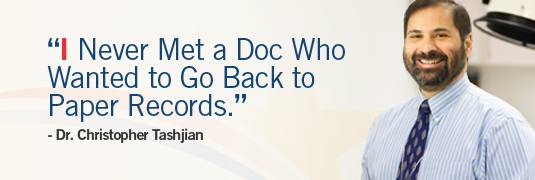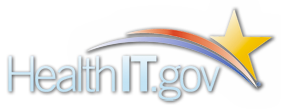Dr. Tashjian's Rural Practice Finds EHR's Allow Patients Gain Control of Their Care And Health


A specialist in family medicine, Dr. Christopher Tashjian practices in rural Ellsworth, WI. In the year since his practice switched to electronic health records (EHRs), Dr. Tashjian has seen his diabetic patients taking more ownership of their care, thanks to printed visit summaries with follow-up instructions. Dr. Tashjian is one of the Meaningful Use Vanguard ("MUVer") and believes the meaningful use measures are in place to help providers offer patients quality health care. Here is Dr. Tashjian's story.
I practice in rural Ellsworth, WI, a town of about 1,500. I suspect we have more cows than people! We implemented our EHR about a year ago, and have done everything we can to make it help us provide better care to our patients.
Every single meaningful use measure for EHRs is aimed at improving patient care. As a practicing physician who spends most of the time in the office, I can say a lot of thought went into meaningful use. The meaningful use requirements are not just hoops to jump through – these are actually things that can help us improve care and practice better medicine. I've seen it firsthand.
One of the meaningful use requirements is an after-visit summary. When we first implemented EHRs in our practice a year ago, we didn't have access to an after-visit summary. But our vendor implemented this feature in our EHR system, and we are now able to create and print visit summaries for every patient when they leave. This office-visit summary includes the medications they're taking, the ones we've changed, when we want them back for another office visit, a list of any lab tests done today, and any special instructions about their treatment plan. If it's a young mother with a new child, she gets all the data on the child – including a reminder for when the next check-up and immunizations are due. If it's an elderly parent who's on six or eight different medications, it helps clear up any miscommunication that we had before the EHR.
More Patients Take Ownership of Their Care
An average diabetic patient is on eight different medicines, and we're doing testing on them a minimum of twice a year. It's really nice to say, "Here's your list of medicines. Here are the blood tests that we did today. And these are the things I want you to do." Two things happen: Because I'm typing it and not handwriting it, they can actually read it. They put the sheet on their refrigerator, and they remember it. I see more and more people coming in with folders where they're keeping track of this. It's ownership of their care.
Another meaningful use requirement that helps ensure patient safety is e-prescribing. A while ago, the U.S. Food and Drug Administration (FDA) issued a statement about a cholesterol medication. The FDA was concerned about the dosage of a common cholesterol medication when used in combination with a certain high blood pressure medication. Since my EHR has e-prescribing capabilities, I was able to search our database of patients and identify the more than 1,400 patients who were taking the cholesterol medication as well as the 250 who were taking both medications.
We contacted the patients and dropped their dosages to the appropriate level identified by the FDA. These patients are now coming in for check-ups to make sure their cholesterol is being effectively managed with the lower dosage.
Before e-prescribing, I'd get a call back from the pharmacist who would say, "You forgot to put if you want any refills." Now, the computer doesn't let me submit it until everything's filled in. Our EHR also connects with our practice management system, so the EHR knows the patient's health plan – which drugs are on the plan's approved formulary list and which are not. I used to talk to the pharmacist two, three times a day. Now I don't talk to him more than once or twice a month – and that's because I call asking him a question.
Meaningful use also required that our system has compatibility checks to make sure the drugs we prescribe are compatible and do not interact adversely with other drugs the patient may be taking. With my current EHR, every prescription I write is automatically checked for possible adverse drug interactions.
Refilling Prescriptions from Estonia
Last summer, I was in Estonia at a McDonald's. And I had a patient email me and say, "I'm out of my high blood pressure meds." Because I now have a mobile app for my EHR, I was able to get into the patient's medical record through my smart phone and look up the needed prescription. Then, I refilled it in the local pharmacy, over the Web. If I can access the Internet, whether it's on my iPad, my laptop, or my smart phone, I can access a medical record.
You can't be available 24 hours a day, seven days a week. But the information is, and that's the important part. So if a patient calls my partner who's covering that night, she can go on her smart phone or on a computer, and look up the patient's medical record. I recently chaperoned a group of local Boy Scouts on a trip to Sweden. I felt confident being so far away from my patients. As long as I could access an Internet connection, I could pull up a patient's medical record if I needed to do so while I was abroad.
Now I have an 80-year-old grandmother who's waiting for us to open up a patient portal, so she can check her health record. We're investing in a patient portal now. Next year, we want to do something like a healthy hub, so we can start exchanging information with other providers. Our EHR continues to improve. This year, we have new capabilities that we didn't have last year. Next year will be even better. This was not the case in more than 20 years of using a paper record. We have formed a great working relationship with our Regional Extension Center, the Wisconsin Health Information Technology Extension Center (WHITEC) ![]() and our vendor to continually improve our electronic records.
and our vendor to continually improve our electronic records.
I'm already able to electronically share immunization records with the State of Wisconsin. We did a beta test, and now when we record our immunizations into our EHR, this information automatically goes into the state's immunization registry. Now that we have access to great new data, we are going to contact our patients with heart disease and diabetes who have not received the flu vaccine and advise them to come in and get a "flu shot." Then we will be concentrating on our healthy population according to risk by age and other chronic illnesses. We could never do this kind of management on paper.
We're also trying to work with our local public health departments to find a way to electronically report communicable diseases that we currently have to do by paper – the form is a kind of a pain to fill out. If we can do that electronically, so much the better.
I've met a lot of docs who said that going from paper to electronics was tough. But I've never met a doc who said, "I want to go back to paper." EHRs have clearly improved quality of care, because you can get information when you need it. You make more informed decisions. And you can make better decisions.


